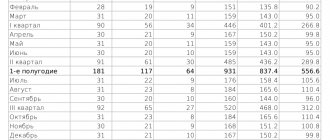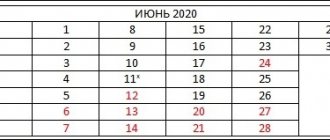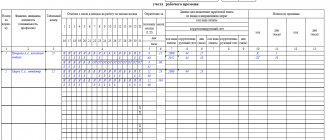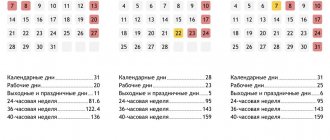In Tsarist Russia
The first law regulating working hours was adopted in the Russian Empire on June 14 (June 2 - old style) 1897. The document, signed by Emperor Nicholas II after a series of workers’ strikes, limited the working day in “factory industry establishments” to 11.5 hours, at night or before holidays to 10 hours. The law introduced for the first time 14 mandatory holidays (13 according to the Orthodox calendar and the New Year), and also established a six-day working week. It was legislated that for Orthodox Christians all Sundays are days off; for non-Christian workers it was allowed to replace them with other days of the week.
Already at the beginning of the 20th century, most enterprises had a nine- or ten-hour working day. The demand for a transition to an eight-hour working day was one of the key ones in the Russian labor movement.
What Stalin saw as economic problems
In his book, the head of the Soviet state, referring to the works of Marx and Engels, in particular, argued the advantages of gradually reducing the working day to 5 hours. The release of the rest of the time, in his opinion, would inevitably contribute to the cultural growth of Soviet workers, who, having received more opportunities for this, would begin to develop comprehensively physically and mentally. A Soviet citizen could choose his profession more freely, and not be chained to the same workplace all his life.
The five-hour working day, according to Stalin, was primarily necessary for workers to use the freed-up time for education. Stalin was going to introduce compulsory polytechnic education - again, so that a person would have wider opportunities in choosing a profession.
Without these and subsequent changes in the social and economic life of the working people, as Stalin was convinced, the transition from the economy of socialism to the economy of communism is impossible.
After the October Revolution
On November 11 (October 29, old style), 1917, by decree of the Council of People's Commissars (SNK), an eight-hour working day was established in Russia and a 48-hour work week with one day off was introduced. Reduced working hours were provided for in industries that were particularly harmful to health. On December 9, 1918, the Labor Code of the RSFSR was adopted, which consolidated these provisions.
From January 2, 1929 to October 1, 1933, in accordance with the resolution of the Central Executive Committee and the Council of People's Commissars, a gradual transition to a seven-hour working day was carried out. The working week was 42 hours. On August 26, 1929, the resolution of the Council of People's Commissars of the USSR “On the transition to continuous production in enterprises and institutions of the USSR” introduced a five-day work week with one day off (four working days in a row, the fifth is a day off).
In November 1931, the Council of People's Commissars of the USSR adopted a resolution in which it allowed the People's Commissariats and other institutions to return to a six-day working week. On June 27, 1940, the decree of the Presidium of the Supreme Soviet of the USSR came into force on the transition to an eight-hour working day with a six-day working week (Sunday is a day off). The working week began to be 48 hours.
After the outbreak of the Great Patriotic War, on June 26, 1941, the Presidium of the Supreme Soviet of the USSR signed a decree “On the working hours of workers and employees in wartime,” according to which mandatory overtime work was introduced from one to three hours a day. Vacations were cancelled. These wartime measures were canceled by decree of the Presidium of the Supreme Soviet of the USSR on June 30, 1945.
Completion of Stakhanov's records
Contents
hide
Completion of Stakhanov's records
What is hidden behind the idea of a five-hour workday?
It is no secret that in the post-war years the main motto of Komsomol members and communists was “Hard work for the good of the Motherland.” But in many construction sites and factories, people tried to exceed the standards, working too hard and not caring about their health.
Very often, grandiose state projects were carried out by prisoners and builders. Productive work on any scale was welcomed and encouraged.
In his memoirs, Stalin named several reasons for switching to 5-hour weekdays:
- Members of society should have time for cultural, sports and polytechnic development.
- Takes care of children's education.
- Strive to improve your status.
To accomplish this task, the state needs to worry about increasing workers’ wages and improving living conditions.
Stalin was confident that in this way the Soviet people would be happy, which is considered the main goal for any state.
Post-war
At the end of the post-war recovery period in 1956-1960, the working day in the USSR was gradually (by sector of the national economy) again reduced to seven hours with a six-day working week (Sunday is a day off), and the working week to 42 hours.
On March 7, 1967, the Central Committee of the CPSU, the Council of Ministers of the USSR and the Central Council of Trade Unions adopted a resolution “On the transfer of workers and employees of enterprises, institutions and organizations to a five-day working week with two days off.” On March 14, 1967, by decree of the Presidium of the Supreme Soviet, a five-day work week with two days off (Saturday and Sunday) was introduced in the USSR. The working day was eight hours. In general education schools, higher and secondary specialized educational institutions, a six-day working week has been introduced, with a seven-hour working day. The working week did not exceed 42 hours.
On December 9, 1971, the Supreme Council of the RSFSR adopted a new Labor Code (LC) of the RSFSR, according to which the working hours of workers and employees could not exceed 41 hours. The USSR Constitution, adopted on October 7, 1977, enshrined this norm (Article 41).
Beria was in favor
One of Stalin’s most influential associates, member of the Politburo of the CPSU Central Committee, USSR Minister of Internal Affairs Lavrentiy Beria supported and even “developed” Stalin’s ideas about the 5-hour working day in his own way.
From Beria's published notes concerning this issue, it is clear that they are entirely complimentary in nature. Moreover, the minister creatively interpreted Stalin’s theses - he said that “with this alone we will bypass capitalism,” which only pursues profit and does not even think about the comprehensive development of its workers. As Beria wrote, Western workers will supposedly reproach their employers: in the USSR they work for 5 hours and live well, but what about us? Let's, they say, give us Soviet power too, so that we can live like people. This is where, as Beria believed, the ground would appear for the peaceful advance of communism in the West.
... Under Stalin, for obvious reasons, no one dared to publicly condemn or even question his plans to shorten the working day. However, almost immediately after the leader’s death, the book “Economic Problems of Socialism in the USSR” was mercilessly criticized (including by representatives of his inner circle) - in particular, Anastas Mikoyan found a “leftist bend” in it, and Georgy Malenkov did not name certain Stalinist theses enough analyzed and economically unjustified.
Restrictions that apply to the operating mode
There is a difference between the concepts of “reduced” work time and “part-time” working mode. Shortened working hours are being introduced for a certain part of employees whose activities fall under preferential categories. It is spelled out in the Code and standardized for each type.
Legislation introduces shortened working weeks for certain categories of persons.
Table 1. Working week - exceptions to the rule
| Category | Number of working hours |
| Child under 16 years of age | 24 hours a week |
| Citizen of the Russian Federation who has reached the age of 16-18 years | 35 hours per week |
| Disabled people of groups 1 and 2 | They also work no more than 35 hours a week |
| Workers in hazardous industries | Limit – 36 hours |
Harmful production conditions lead to a reduction in work
Thus, a reduction in working hours is the norm for those citizens who, due to age, health conditions and special working conditions, cannot work within the normal 40-hour regime. According to the requirements of the law, the employer shortens the working week for such persons.
As for the approval of part-time work in an organization, there may be enough reasons for this. Moreover, this regime depends entirely on the agreement of the parties.
Regardless of what kind of regime is present at the workplace, an entry about shortened and part-time regimes is not made in the work book.
Part-time work is established by agreement
In the table below you can see the comparative characteristics.
Table 2. Comparative analysis of formats
| Criterion | Abbreviated | Incomplete |
| Type of workers | 1. A child under 16 years of age. 2. A citizen of the Russian Federation who has reached the age of 16-18 years. 3. Disabled people of groups 1 and 2. 4. Workers in hazardous industries. | All types of employees, including persons who have the right to work on a short-time basis. |
| Employer's obligation | If an employee’s activities fall under a legislative provision that obliges the use of a shortened working week, then preventing this is not permitted on a legislative basis. | Similar working conditions are formed at the request of any of the parties (boss, performer), on a mutual basis. There are also exceptions in this category when it is not possible to refuse to implement part-time work and is considered a gross violation of the Code. This applies to women bearing children, guardians and trustees who have taken care of persons under the age of 14, or children with disabilities who have not reached the age of majority. This format of work cannot be denied to employees who care for people who need special care for health reasons and who have a specialist’s opinion in their hands. |
| Number of days in a working week and other indicators | They are prescribed in the Labor Code of the Russian Federation and other legislative acts. | Various options are possible by agreement of the parties with varying durations. Participants in labor relations can agree on a part-time workday, fit the workweek into this format, or use a combination of these elements. |
| When and for how long is it relevant? | It begins from the moment an employee is hired and continues until the end of the employment agreement (if we are talking about minors, then this format is relevant until they reach the age of 18). | They are introduced at the stage of signing the agreement with the employee, and can also be introduced later at the initiative of either party. The period is specified in the text. There is a six-month limit when management takes the initiative. |
| Formal basis | Code on relations between employees and managers, and other rules of law that reveal aspects of their interaction. Sometimes the basis is a labor agreement or a collective agreement with the rules enshrined in it that apply at a particular enterprise. | The basis is an additional agreement, which can be found in the annex to the employment agreement; it is drawn up after the corresponding order is issued. |
| Payments | Wages are paid in the amount corresponding to full employment. Workers who have not received the status of adult citizens can count on wages taking into account a reduced work schedule. | Wages are paid within the hours worked according to the schedule or in the context of the work performed. |
Pregnant women have the right to a part-time work schedule
Standard working hours for 2021
An important task for a HR specialist is to correctly determine the standard work time, because thanks to it, the workload and corresponding payments for work are established.
What are the working hours standards for 2021 (table below)? Employees and HR specialists are always concerned about the question of what duration of the labor process is considered normal.
Labor legislation states that 40 hours per week is the normal duration of work. Work and rest schedules in institutions are approved taking into account this figure. However, a schedule of 24 or 36 hours may be normal.
The monthly working time standard for 2021 is determined based on the weekly one, and the number of hours worked by the employee may vary.
Overtime mode
Overtime work may be performed outside the basic schedule. Of course, there must be objective reasons for this. The manager’s mere desire to involve a person in performing work overtime is clearly not enough. The classic case when there is a need for increased loads is associated with the onset of emergencies, industrial emergencies, problems with water, gas and heat supply at the enterprise, interruptions in transport, communications, and electricity supply.
In the situations presented above, the employee’s signature and consent are not required. The work is being carried out under emergency conditions or martial law, so measures to resuscitate the enterprise’s activities will be required from all employees, without exception.
Overtime activities have time limits
If the situation is less urgent, the employee must personally sign a document expressing his desire to work overtime. Moreover, he has every right to refuse to work under such conditions.
It is prohibited to involve pregnant women and minors, as well as disabled people, women with children under 3 years old in overtime work without appropriate consent and a medical certificate allowing them to attend work on overtime conditions.
For overtime work, no more than 120 units of working time are allowed, which are cumulatively added up over one year. An additional legal restriction is that overtime work should not be performed for more than two days in a row in the amount of 4 hours. All hours of work exceeding the normal level are strictly taken into account by the employer. Payment points are clearly presented in the text of the Labor Code. If the first 2 hours are paid at one and a half equivalent, then the next 2 hours of overtime are paid at double the equivalent. Also, allowances are regulated by local production acts.
Reducing overtime pay is not permitted. In this case, the employee chooses what to do with this compensation - receive a payment, or subsequently exchange overtime hours for additional days of rest.
Production calendar 2021
For an accountant and HR specialist, a production calendar becomes an assistant in their activities. It contains a large amount of information about holidays, weekends, and shortened days. The document, for example, indicates how many such days the corresponding period includes, what the work standard is for working weeks of different lengths (24, 36, 40 hours) in each half-year, quarter, month and year as a whole. From the document you can find out what dates certain professional holidays fall on.
The calendar helps the accountant correctly calculate wages, sick leave, vacation pay, and determine work schedules. This document will help the employee choose the appropriate period for vacation.
In 2020, the calendar shows the following important events:
1. Weekends have been postponed
- from Saturday 05.01 to Thursday 02.05;
- from Sunday 06.01 to Friday 03.05
- from Saturday 23.02 to Friday 10.05.
2. Holidays are days off
- from 01.01 to 08.01 - New Year holidays;
- 07.01 - Christmas;
- 23.02 — Defender of the Fatherland Day;
- 08.03 — International Women's Day;
- 01.05 — Spring and Labor Day;
- 09.05 — Victory Day;
- 12.06 — Russia Day;
- 04.11 — Day of National Unity.
3. Abbreviated days are:
- 22.02;
- 07.03;
- 30.04;
- 08.05
- 11.06;
- 31.12.
Working hours at night
If the employee’s duties require him to work in a period of time that is not biologically intended for this, from 10 p.m. to 6 a.m., then his shift (it would no longer be entirely correct to say “working day,” since this means night) should be 1 hour shorter than corresponding daily. The pay for such shifts is also increased.
REFERENCE! A night shift will be considered if at least half of its duration falls within the specified time period.
If an employee works on a short-time or part-time basis, his night shift will not be reduced.
When the obligation to work at night is fixed in the collective agreement, the reduction is also not made.
How to attract an employee to work at night ?








